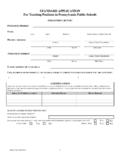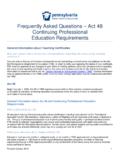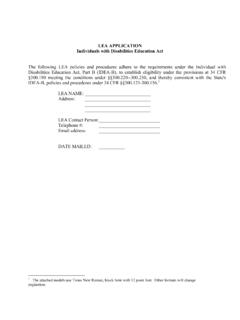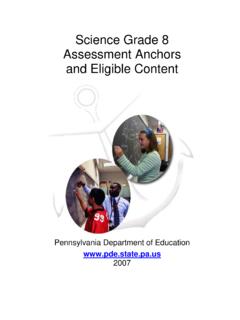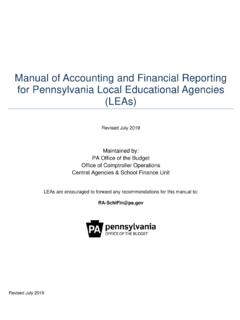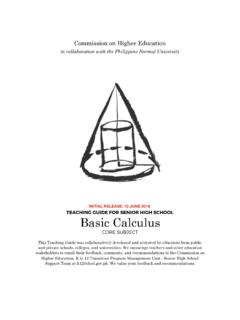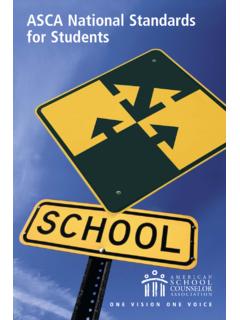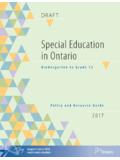Transcription of Career Readiness Guidance - Pennsylvania Department of ...
1 Career Readiness Indicator for the Future Ready PA Index and ESSA. Accountability: Guidelines for Evidence Collection, Monitoring, and Reporting Purpose Beginning in the 2017-18 school year, school entities will report student-level data for the Career Readiness Indicator in the Pennsylvania Information Management System (PIMS).1 This document provides Guidance for evidence collection, monitoring, and reporting students for this measure. Introduction By 2025, more than six in 10 Pennsylvania jobs will require some form of postsecondary education or In addition, the overwhelming majority of STEM jobs in Pennsylvania (91. percent) will require some form of postsecondary education and Currently, 45 percent of Pennsylvanians hold these credentials,4 and a significant skills gap especially for middle skills occupations requiring some postsecondary training but not a four-year degree.
2 Continues to persist for the commonwealth's current and emerging Pennsylvania 's economic future depends on having a well-educated and skilled workforce that is prepared to meet the current and projected demands of a global, knowledge-based 21st century economy. Therefore, it is imperative that Pennsylvania students at all educational levels have access to high-quality academic and technical education, as well as opportunities to assess interests, build skills, and identify and explore careers aligned to those interests and skills. Regardless of their postsecondary plans, all students should leave secondary education with a solid foundation in Career education and 1. 2017-2018 Pennsylvania Information Management System User Manual Volume 1 2.
3 Carnevale, N. Smith, and J. Strohl, Recovery: Job Growth and Education Requirements Through 2020, Georgetown University, Center on Education and the Workforce, June 2013. 3 Carnevale, N. Smith, and J. Strohl, Recovery: Job Growth and Education Requirements Through 2020, Georgetown University, Center on Education and the Workforce, June 2013. 4 Educational Attainment for Pennsylvanians 18 years and over by county, sex and age, Census Bureau, 2010-2014 American Community Survey 5- Year Estimates. 5. Carnevale, N. Smith, and J. Strohl, Recovery: Job Growth and Education Requirements Through 2020, Georgetown University, Center on Education and the Workforce, June 2013. 6 The Pennsylvania Career Education and Work Standards identify what students should know and be Revised December 2019 1.
4 In 2006, the Pennsylvania State Board of Education promulgated regulations (22 Pa. Code Chapter 4)7 establishing the state Academic Standards for Career Education and Work (CEW. standards) and making the standards required education for all students in Pennsylvania . (Note: More detailed definitions, including evidence requirements, can be found in Implementation on pages 5-6.) The CEW standards address four areas of knowledge: Career Awareness and Preparation (Section );. Career Acquisition (Getting a Job) (Section );. Career Retention and Advancement (Section ); and Entrepreneurship (Section ).8. In addition, Pennsylvania regulation (Chapter 339) established the development and implementation of a comprehensive program of K-12 Guidance services aligned to the CEW.
5 Standards and requires all school entities to integrate the CEW standards into the curriculum. Since the adoption of these CEW standards in 2006, the Department has worked with educators, administrators, business and industry leaders, and other stakeholders to develop resources to ensure that all students have access to rigorous, standards-based (See Appendix D for additional information.). Background To help ensure that all students in Pennsylvania are on track for meaningful postsecondary engagement and success, the Department has included a measure of students' Career exploration, preparation, and Readiness as part of Pennsylvania 's state and federal accountability system through the Future Ready PA Index and under the Every Student Succeeds Act (ESSA).
6 The Career Readiness Indicator recognizes efforts to ensure that all students have access to Career exploration and preparation activities that are standards-aligned and evidence-based, including the development of Career plans and portfolios that help students identify pathways and opportunities for postsecondary success. The Career Readiness Indicator identifies the percentage of students in a reporting cohort who demonstrate meaningful engagement in Career exploration and preparation and implementation of individualized Career plans through separate, specific measures based on grade level benchmarks aligned to the CEW standards. The benchmarks are as follows: 1. The percentage of students who, by the end of grade 5, demonstrate engagement in able to do at grades 3, 5, 8, and 11 in four specific areas: Career awareness and preparation; Career acquisition (getting a job); Career retention and advancement; and entrepreneurship.
7 In addition, Pennsylvania regulation (Chapter 339) requires school districts to develop and implement Career /occupational exploration plans for students in grades K- 12 that are aligned with the state's Career Education and Work Standards. 7 #.VfnY0FT. D_Vg 8 #.VfnY0FT. D_Vg 9 #tab-1. Revised December 2019 2. Career exploration and preparation aligned to the CEW standards, via PA CareerZone or a locally designed Career exploration and preparation program/curriculum. 2. The percentage of students who, by the end of grade 8, create an individualized Career plan and participate in Career preparation activities aligned to the CEW standards. 3. The percentage of students who, by the end of grade 11, implement their individualized Career plan through ongoing development of a Career portfolio and participation in Career preparation activities aligned to the CEW standards.
8 As a part of state and federal accountability, the indicator also aims to promote access and inclusion for Career Readiness activities for historically underserved students, including English language learners, students with disabilities, economically disadvantaged students, students of color, and students in nontraditional fields. Terms and Definitions Career Education and Work in accordance with 22 Pa. Code (5), Career education and work is defined as understanding Career options in relationship to individual interests, aptitudes and skills including the relationship between changes in society, technology, government and economy and their effect on individuals and careers. Development of knowledge and skill in job-seeking and job-retaining competencies and, for students completing Career -technical programs, the skills to succeed in the occupation for which they are prepared.
9 10. Career Plan In accordance with the CEW standards, a Career plan is a document or similar item developed by the student that identifies a series of educational studies and experiences to prepare them for postsecondary education or work, or both, in a selected Career cluster or area. 11. Career portfolio In accordance with the CEW standards, a Career portfolio is an ongoing, individualized collection of materials (electronic or hard copy) that documents a student's educational performance, Career exploration, and employment experiences over time. While there is no prescribed or standard format that a Career portfolio must take, it typically includes a range of work, containing assignments by the teacher/counselor and selections by the student.
10 It serves as a guide for the student to transition to postsecondary education/training, or the workplace, or both. 12. College and Career Readiness Pennsylvania learners will be prepared for meaningful engagement in postsecondary education, in workforce training, in Career pathways, and as responsible, involved Curriculum A series of planned instruction aligned with the academic standards in each subject that is coordinated, articulated, and implemented in a manner designed to result in 1022 Pa. Code (5). 11 22 Pa. Code Chapter 4 Academic Standards for Career Education and Work 12 22 Pa. Code Chapter 4 Academic Standards for Career Education and Work 13 #tab-1. Revised December 2019 3. achievement at the proficient level by all High Priority Occupations High Priority Occupations are job categories that are in demand by employers, have evolving skill needs, and are likely to provide family-sustaining wages.

